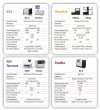Deep sequencing: becoming a critical tool in clinical virology
- PMID: 24998424
- PMCID: PMC4119849
- DOI: 10.1016/j.jcv.2014.06.013
Deep sequencing: becoming a critical tool in clinical virology
Abstract
Population (Sanger) sequencing has been the standard method in basic and clinical DNA sequencing for almost 40 years; however, next-generation (deep) sequencing methodologies are now revolutionizing the field of genomics, and clinical virology is no exception. Deep sequencing is highly efficient, producing an enormous amount of information at low cost in a relatively short period of time. High-throughput sequencing techniques have enabled significant contributions to multiples areas in virology, including virus discovery and metagenomics (viromes), molecular epidemiology, pathogenesis, and studies of how viruses to escape the host immune system and antiviral pressures. In addition, new and more affordable deep sequencing-based assays are now being implemented in clinical laboratories. Here, we review the use of the current deep sequencing platforms in virology, focusing on three of the most studied viruses: human immunodeficiency virus (HIV), hepatitis C virus (HCV), and influenza virus.
Keywords: Deep sequencing; Hepatitis C virus (HCV); Human immunodeficiency virus (HIV); Influenza virus; Next generation sequencing (NGS).
Copyright © 2014 Elsevier B.V. All rights reserved.
Figures



Similar articles
-
Next-generation sequencing technologies in diagnostic virology.J Clin Virol. 2013 Oct;58(2):346-50. doi: 10.1016/j.jcv.2013.03.003. Epub 2013 Mar 21. J Clin Virol. 2013. PMID: 23523339 Review.
-
Loeffler 4.0: Diagnostic Metagenomics.Adv Virus Res. 2017;99:17-37. doi: 10.1016/bs.aivir.2017.08.001. Epub 2017 Sep 21. Adv Virus Res. 2017. PMID: 29029726 Free PMC article. Review.
-
Next-generation sequencing technology in clinical virology.Clin Microbiol Infect. 2013 Jan;19(1):15-22. doi: 10.1111/1469-0691.12056. Clin Microbiol Infect. 2013. PMID: 23279287 Review.
-
Applications of next-generation sequencing technologies to diagnostic virology.Int J Mol Sci. 2011;12(11):7861-84. doi: 10.3390/ijms12117861. Epub 2011 Nov 14. Int J Mol Sci. 2011. PMID: 22174638 Free PMC article. Review.
-
Virome genomics: a tool for defining the human virome.Curr Opin Microbiol. 2013 Aug;16(4):479-84. doi: 10.1016/j.mib.2013.04.006. Epub 2013 May 23. Curr Opin Microbiol. 2013. PMID: 23706900 Free PMC article. Review.
Cited by
-
Evolutionary Analysis of the VP1 and RNA-Dependent RNA Polymerase Regions of Human Norovirus GII.P17-GII.17 in 2013-2017.Front Microbiol. 2019 Sep 27;10:2189. doi: 10.3389/fmicb.2019.02189. eCollection 2019. Front Microbiol. 2019. PMID: 31611853 Free PMC article.
-
Measurement error and variant-calling in deep Illumina sequencing of HIV.Bioinformatics. 2019 Jun 1;35(12):2029-2035. doi: 10.1093/bioinformatics/bty919. Bioinformatics. 2019. PMID: 30407489 Free PMC article.
-
Sequence-Independent, Single-Primer Amplification Next-Generation Sequencing of Hantaan Virus Cell Culture-Based Isolates.Am J Trop Med Hyg. 2017 Feb 8;96(2):389-394. doi: 10.4269/ajtmh.16-0683. Epub 2016 Nov 28. Am J Trop Med Hyg. 2017. PMID: 27895275 Free PMC article.
-
Added Value of Next-Generation Sequencing for Multilocus Sequence Typing Analysis of a Pneumocystis jirovecii Pneumonia Outbreak1.Emerg Infect Dis. 2017 Aug;23(8):1237-1245. doi: 10.3201/eid2308.161295. Emerg Infect Dis. 2017. PMID: 28726611 Free PMC article.
-
Single primer isothermal amplification (SPIA) combined with next generation sequencing provides complete bovine coronavirus genome coverage and higher sequence depth compared to sequence-independent single primer amplification (SISPA).PLoS One. 2017 Nov 7;12(11):e0187780. doi: 10.1371/journal.pone.0187780. eCollection 2017. PLoS One. 2017. PMID: 29112950 Free PMC article.
References
-
- Holley RW, Apgar J, Everett GA, Madison JT, Marquisee M, Merrill SH, et al. Structure of a Ribonucleic Acid. Science. 1965;147:1462–1465. - PubMed
-
- Baer R, Bankier AT, Biggin MD, Deininger PL, Farrell PJ, Gibson TJ, et al. DNA sequence and expression of the B95-8 Epstein-Barr virus genome. Nature. 1984;310:207–211. - PubMed
-
- Ratner L, Haseltine W, Patarca R, Livak KJ, Starcich B, Josephs SF, et al. Complete nucleotide sequence of the AIDS virus, HTLV-III. Nature. 1985;313:277–284. - PubMed
Publication types
MeSH terms
Grants and funding
LinkOut - more resources
Full Text Sources
Other Literature Sources
Medical

